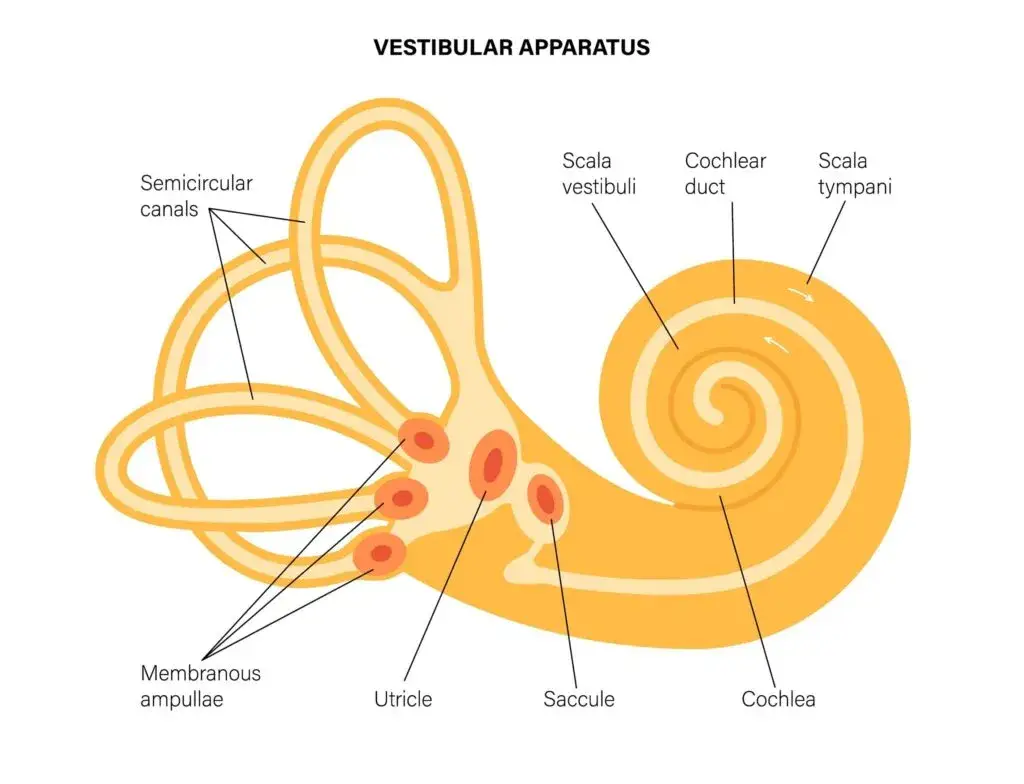
Why am I lightheaded? Feeling lightheaded can be unsettling—like your body suddenly “drops out of gear.” Maybe it happens when you stand up from the couch, look down at your phone too long, turn your head quickly, or walk the aisles at the grocery store. For some people, it’s an occasional blip. For many others, it’s a persistent pattern that steals confidence, derails daily plans, and leaves them searching the internet for answers at 2 a.m.
If that’s you, you’re not alone—and you’re not imagining it. Lightheadedness is a real signal that the body’s control systems are working harder than they should. Three common threads often run through these stories: POTS (Postural Orthostatic Tachycardia Syndrome), vertigo, and dysautonomia. Each involves the autonomic nervous system—the brain-body autopilot regulating heart rate, blood pressure, breathing, balance, and digestion. And there’s a fourth thread that’s easy to miss but critical to address: upper cervical alignment, especially at the atlas (C1)—the top bone of the neck that wraps around the lower brainstem and sits beside key blood vessels and nerves.
At Lavender Family Chiropractic in Sarasota, Florida, our focus is precise, gentle upper cervical chiropractic. We use 3D CBCT imaging and Tytron functional nervous system scans to find subtle atlas misalignments that can disturb blood flow, nerve signaling, and the brain’s ability to coordinate balance and circulation. Then we correct those misalignments with careful, individualized adjustments—no twisting, popping, or cracking—to help your body restore the stability you’ve been missing.
This in-depth guide explains why lightheadedness happens, how POTS/vertigo/dysautonomia interrelate, why the upper neck is a pivotal control point, and what our team—Dr. Rusty Lavender, Dr. Jacob Temple, and Dr. Will Guzinski—does to help people in Sarasota, Bradenton, Lakewood Ranch, Parrish, Venice, Osprey, Punta Gorda, St. Petersburg, Siesta Key, Longboat Key, Lido Key, and Myakka City feel steady again.
Why am I Lightheaded? Lightheadedness vs. Vertigo: Two Distinct Sensations
Many people use “dizzy” to describe both lightheadedness and vertigo, but the body reads them differently:
- Lightheadedness feels like you could pass out—your vision may dim, your hearing may muffle, your legs can feel hollow, and your heart might race. It’s often tied to orthostatic stress (standing up) and changes in blood pressure/heart rate regulation.
- Vertigo is the sensation that you or the room is spinning, tilting, or swaying. It’s commonly linked to inner ear or vestibular mismatches—and can be provoked by head movements, looking up, or rolling over in bed.
Both can overlap with dysautonomia, because the same control centers in the brainstem and upper cervical region coordinate blood flow, vestibular input, eye movement, and posture. When those signals desynchronize—even briefly—lightheadedness and vertigo can take the stage.
POTS in Plain English
Postural Orthostatic Tachycardia Syndrome (POTS) occurs when the heart rate spikes excessively upon standing (often 30–40+ beats per minute higher than when sitting/lying down) without an adequate rise in blood pressure. People with POTS often report:
- Lightheadedness or near-fainting when standing
- Palpitations and chest discomfort
- Brain fog and shortness of breath
- Fatigue, exercise intolerance, and “crashing” after activity
- Temperature intolerance, GI upset, and sometimes “drop attacks”—sudden weakness or brief loss of tone without full loss of consciousness
POTS is a regulation problem, not a character flaw or a lack of willpower. The autonomic nervous system is working overtime to keep blood flowing to the brain against gravity—and the system is inefficient or mis-signaled. While hydration, electrolytes, and graded activity can help, many patients continue to struggle until the control hub in the upper neck is assessed and supported.
Dysautonomia: When Autopilot Falters
Dysautonomia is a broad term for autonomic dysfunction. Subtypes include POTS, orthostatic hypotension, neurocardiogenic syncope, and more. Typical features are:
- Fluctuating heart rate and blood pressure
- Lightheadedness with standing or after meals
- Heat intolerance and abnormal sweating
- GI changes (nausea, constipation/diarrhea)
- Anxiety-like symptoms that start in the body, not necessarily the mind
Think of your autonomic nervous system as a network of sensors (baroreceptors, vestibular input, cervical proprioceptors), processors (brainstem nuclei), and effectors (vessels, heart, diaphragm). If any part of the loop is miscalibrated—for example by atlas misalignment contorting the input/output wiring near the brainstem—the result can be a daily tug-of-war with gravity and motion.
Vertigo: The Inner Ear Meets the Upper Neck
Classic BPPV (benign paroxysmal positional vertigo) happens when calcium crystals in the inner ear shift into a canal where they don’t belong, causing a spinning sensation with head movement. But many people with “vertigo-like” symptoms do not fit neatly into BPPV. They may have:
- Vestibular migraine
- MdDS (Mal de Débarquement) or “rocking boat” sensations
- Cervicogenic dizziness—a mismatch between neck position signals and vestibular/visual input
- Persistent dizziness with heavy screen use, grocery-store aisles, or busy visual patterns
The upper cervical spine is a sensor-dense region. Tiny muscles and ligaments around C0–C2 feed the brain constant information about head position. If the atlas is misaligned, those signals can become noisy or contradictory, confusing the balance system and producing vertigo, unsteadiness, or motion sensitivity.
Why the Atlas (C1) Is a Control Tower
The atlas sits just under your skull and encircles the lower brainstem. It neighbors:
- Vertebral arteries/veins that supply and drain the brain
- The vagus nerve (parasympathetic control: heart rate, digestion, calm/rest)
- Sympathetic chain fibers (fight/flight tone: vessel constriction, alertness)
- Dural structures that influence CSF (cerebrospinal fluid) dynamics
A subtle atlas misalignment—often from a past whiplash, sports concussion, fall, or even long-term postural strain—can create a web of downstream effects:
- Altered blood flow: Kinks or tension around vertebral vessels can change how blood moves into and out of the skull. Even small disruptions can be felt when you move or stand.
- Vagal irritation: The vagus nerve controls resting heart rate and supports healthy blood pressure responses. Mechanical stress or inflammation near the upper cervical region can blunten parasympathetic “braking power.”
- Sympathetic upshift: If parasympathetic tone is dialed down, sympathetic tone often fills the gap—leading to tachycardia, lightheadedness, and anxiety-like sensations.
- CSF and venous drainage: Subtle changes in the upper neck can influence intracranial pressure dynamics, which some patients perceive as head pressure, fullness, or fog.
- Proprioceptive mismatch: Faulty neck position signals can clash with inner ear and visual input, creating disequilibrium or visual vertigo.
When we correct atlas alignment gently and specifically, many people notice better steadiness, clearer thinking, calmer heart rate, and more predictable energy—not because we “treat POTS” or “treat vertigo” directly, but because we restore the body’s control hub to do its job.
Common Triggers We See Before Symptoms Begin
- Auto accidents and whiplash
- Sports impacts or falls (even years prior)
- Concussions or repetitive heading in sports
- Dental/orthodontic changes altering jaw and cranio-cervical mechanics
- Prolonged screen posture (forward head, elevated shoulders)
- Infections or inflammation that tip a fragile system over the edge
- Sleep or stress debt, amplifying autonomic strain
Symptoms often ramp up slowly, then snowball—until the pattern feels constant.
How Lavender Family Chiropractic Finds the Root Cause
We are not guessing. We build a picture of your unique anatomy and nervous system function so your care is precise from day one:
- 3D CBCT Imaging (Cone-Beam CT)
This lets us see the atlas, axis, joints, and surrounding structures in three dimensions. We evaluate exact vectors of misalignment down to millimeters and degrees. No two atlases misalign the same way—so no two corrections should be the same. - Tytron Infrared Thermography (Functional Nervous System Scans)
These scans track thermal asymmetries along the spine that correlate with autonomic tone and nerve irritation. We use them to determine when to adjust and when to let your body integrate. - Orthostatic and Balance Observations
While we are not a cardiology lab, we do pay attention to postural vitals, sway, head carriage, and gait. Real-life function informs clinical decisions. - Posture and Range-of-Motion Analysis
We map subtle imbalances—shoulder height, pelvic tilt, and head tilt/rotation—that often trace back to atlas orientation. - History with Intention
We listen carefully to the timeline: first symptoms, injuries, dental work, illnesses, hormonal shifts, and stressors. Your story matters.
Our Upper Cervical Adjustments: Gentle, Specific, Effective
Upper cervical chiropractic is not general twisting or cracking. Using your CBCT measurements, we apply a precise vector correction to the atlas with a gentle approach (often an advanced knee-chest or instrument-assisted method) that coaxes the joint back to neutral. Patients frequently say, “That was it?” because the adjustment is so light. The goal isn’t force—it’s accuracy.
Equally important: we don’t adjust every visit. We check your scans and objective findings; if you’re holding your correction, we let the body heal without additional input. That’s how we help the nervous system stabilize rather than constantly chasing symptoms.
What Progress Looks Like
Improvement often unfolds in phases:
- Stabilization (Weeks 1–4): Many patients notice fewer “bad spells,” less head pressure, and improved steadiness standing or turning the head. Sleep can shift first as the nervous system calms.
- Integration (Weeks 4–12): Brain fog lifts more consistently, heart rate fluctuations settle, and confidence returns with daily activity. You begin doing more with less payback.
- Resilience (Months 3–6): You hold your correction longer; therapy spacing increases. You test old triggers—busy stores, hot days, longer walks—with better outcomes.
Everyone heals at their own pace, but we celebrate inches and miles. The throughline is autonomic balance: when the control hub is centered, the body stops overreacting to normal life.
What You Can Do at Home (Complementary, Not a Substitute)
While upper cervical care is our focus, supportive habits can amplify your progress:
- Hydration and Electrolytes: Many POTS/dysautonomia patients do better with higher fluid and mineral intake (discuss specifics with your physician).
- Diaphragmatic Breathing: Slow, deep breaths stimulate the vagus nerve and improve venous return.
- Smart Heat Exposure: Use cooling strategies on hot days; heat can dilate vessels and worsen orthostatic symptoms.
- Gentle, Graded Movement: Recumbent bike, rowing, or walking with gradual increases helps the autonomic system tolerate upright time.
- Visual Hygiene: Take screen breaks; soften harsh lighting; reduce rapid-scrolling sessions that challenge visual-vestibular processing.
- Neck-Friendly Ergonomics: Raise screens, support your elbows, and keep the head over the shoulders to reduce upper cervical strain.
- Sleep Rituals: Consistency and a calm wind-down stabilize autonomic tone overnight.
These are add-ons, not replacements, for a clear plan to correct atlas misalignment.
Red Flags That Need Immediate Medical Attention
While lightheadedness is often benign, call your doctor or emergency services if you experience chest pain, shortness of breath at rest, fainting with injury, one-sided weakness, facial droop, slurred speech, sudden severe headache, or new neurological deficits. Upper cervical chiropractic is a complement to appropriate medical care; safety comes first.
Who We Help Most Often
We commonly see:
- People with recurrent lightheadedness or vertigo after a car accident or sports injury (even years later)
- Individuals with POTS/dysautonomia who get partial relief from salt/fluids/compression but still feel unstable
- Patients with vestibular migraine or cervicogenic dizziness who feel worse with screens, fluorescent lights, or fast head turns
- Those with brain fog, fatigue, and head pressure that ebb and flow with posture or sleep quality
- Teens and adults who feel they’ve “tried everything” and are ready to evaluate the upper cervical root cause
Two Case Snapshots (Names Changed for Privacy)
- Emily, 28: After a minor car accident two years earlier, Emily developed on-and-off lightheadedness that turned into daily near-fainting when standing. She was later told she likely had POTS. Labs were “normal,” yet she couldn’t grocery shop without holding the cart to stay upright. Her CBCT showed a right posterior atlas with rotational components; Tytron scans indicated persistent asymmetry. We corrected the misalignment and monitored carefully. Within four weeks, Emily reported fewer “gray-out” spells and could stand to cook dinner. By week ten, her resting heart rate and postural spikes steadied, and she was walking 20–30 minutes comfortably.
- Mark, 52: Mark described “boat-deck” unsteadiness, worse in big box stores and when turning quickly. Vestibular testing was inconclusive; meclizine made him foggy. His CBCT revealed an atlas tilt altering head posture; Tytron scans were intermittently positive. After a series of gentle, precise corrections, Mark’s visual-motion sensitivity diminished, and he returned to gym workouts without the “wobble.”
Every patient is unique, but when the control tower (atlas/brainstem) is centered, the whole airport runs better.
Why Choose Lavender Family Chiropractic in Sarasota
- Upper Cervical Focus: This is all we do—so every detail of your care is tailored to the C0–C2 region.
- 3D CBCT + Tytron Scans: We don’t guess. We measure, adjust, and re-check for objective progress.
- Gentle, Precise Adjustments: No popping, twisting, or cracking. Comfort and accuracy matter.
- Three-Doctor Team: Dr. Rusty Lavender, Dr. Jacob Temple, and Dr. Will Guzinski collaborate on complex cases and continuity of care.
- Root-Cause Roadmap: We aim for long-term stability, not short-lived symptom chasing.
- Local, Patient-Centered: We proudly serve Sarasota, Bradenton, Lakewood Ranch, Parrish, Venice, Osprey, Punta Gorda, St. Petersburg, Siesta Key, Longboat Key, Lido Key, and Myakka City with a warm, professional approach.
Searching “chiropractor near me,” “upper cervical chiropractor near me,” “chiropractor Sarasota Florida,” “Vertigo doctor near me,” or “Migraine doctor near me”? You’ll find us ready to help you feel steady again.
Frequently Asked Questions: Top 15
- What’s the difference between POTS and simple dehydration?
Dehydration can cause lightheadedness, but POTS involves an exaggerated heart-rate response to standing that persists even with adequate fluids/electrolytes. Many patients improve hydration and still struggle until autonomic regulation is addressed. - Can an atlas misalignment really affect heart rate and blood pressure?
The atlas surrounds the lower brainstem where autonomic centers integrate baroreflex, vagus, and sympathetic outputs. A misalignment can distort inputs and increase sympathetic tone, leading to tachycardia and lightheadedness. - How is this different from general chiropractic?
Upper cervical chiropractic focuses specifically on C0–C2, using 3D CBCT to calculate exact correction vectors. It’s gentle and precise, with an emphasis on holding the correction rather than frequent forceful adjustments. - Do you treat vertigo like BPPV?
If your vertigo is classic BPPV, we’ll coordinate appropriate care, which may include specific maneuvers or referrals. When dizziness is neck-driven, correcting atlas orientation and cervical proprioception can reduce symptoms dramatically. - What role does the vagus nerve play in dysautonomia?
The vagus is the body’s parasympathetic “brake.” If vagal signaling is blunted, the sympathetic system can dominate, causing racing heart, GI shifts, and anxiety-like sensations. Restoring upper cervical neutrality can support vagal balance. - Will I hear or feel a crack during the adjustment?
No. Our method is gentle and targeted, designed for comfort and precision. Many patients are surprised by how subtle it feels—and how profound the results can be. - How quickly will I notice changes?
Some people feel lighter or clearer within days; others need several weeks as the nervous system recalibrates. We track progress with Tytron scans, posture checks, and your symptom changes. - Can teenagers with POTS benefit from upper cervical care?
Yes. We see teens and adults. Because growing bodies are adaptable, correcting atlas alignment early can be especially impactful. - What if I also have EDS or MCAS?
Complex cases with hypermobility (EDS) or mast cell activation often benefit from gentle, precise care that avoids excessive force. We coordinate with your other providers to support stability. - Is upper cervical care safe after concussion or whiplash?
Yes—our approach is conservative and specific, making it well-suited to post-trauma patients. We use CBCT to guide decisions and never force motion through restricted segments. - Do you take insurance?
Our office is out of network. Many patients receive a superbill to submit for reimbursement based on their coverage. We offer various payment and financing options. - How do you know when to adjust—or not?
We use Tytron thermography, posture findings, and your clinical picture. If you’re holding your correction, we don’t adjust. That’s how we build long-term stability. - Can upper cervical chiropractic cure POTS?
We don’t claim cures. Our role is to remove mechanical and neurological interference at the control hub (atlas/brainstem) so your autonomic system functions better. Many patients report fewer episodes, steadier heart rate, clearer thinking, and more reliable energy. - What if my cardiologist or neurologist is already helping me?
Great—keep that care. We complement your team by addressing the structural-neurological component in the upper neck that medications and general rehab may not target. - How do I get started?
Call (941) 243-3729 or visit www.chiropractorsarasotaflorida.com to schedule a complimentary consultation. We’ll review your history, perform scans, and explain your individualized plan.
Your Next Step: From Unsteady to Steady
Lightheadedness is more than an inconvenience; it’s a sign your autonomic control systems are working too hard. Whether your pattern looks like POTS, vertigo, or broader dysautonomia, there’s a real possibility that an atlas misalignment is amplifying the noise in your system. When we calm that noise—gently, precisely, and objectively—your body can get back to doing what it’s designed to do: self-regulate.
Lavender Family Chiropractic in Sarasota Florida offers complimentary consultations to learn more about you. Click the link below!
https://intake.chirohd.com/new-patient-scheduling/724/lavender-family-chiropractic
Visit our Website!
To learn more about us go to http://www.chiropractorsarasotaflorida.com
We also service Bradenton, Parrish, Ellenton, Ruskin, Venice, Tampa, St. Pete, Osprey, Longboat, Lakewood Ranch, Myakka City.
If you are in Tampa, Fort Myers, or Salt Lake City, you can visit my other locations! NeckWise Upper Cervical. Visit, www.neckwise.com
If you are not local, visit www.uccnearme.com to find a doctor in your area.
If you’re searching for a chiropractor Sarasota Florida, “upper cervical chiropractor near me,” “Vertigo doctor near me,” or “Migraine doctor near me,” our team at Lavender Family Chiropractic is here to help you move from uncertainty to confidence.
- Phone: (941) 243-3729
- Website: www.chiropractorsarasotaflorida.com
- Address: 5899 Whitfield Ave Ste 107, Sarasota, FL 34243
- Doctors: Dr. Rusty Lavender, Dr. Jacob Temple, and Dr. Will Guzinski
- Service Areas: Sarasota, Bradenton, Lakewood Ranch, Parrish, Venice, Osprey, Punta Gorda, St. Petersburg, Siesta Key, Longboat Key, Lido Key, and Myakka City
Schedule your complimentary consultation today. Let’s help your head feel clear, your feet feel steady, and your days feel like yours again





